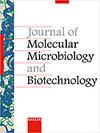HA1-2-fljB疫苗诱导小鼠对猪源性H1N1流感病毒的免疫应答
IF 1.2
Q2 Biochemistry, Genetics and Molecular Biology
引用次数: 4
摘要
2009年,一种新型猪源性甲型H1N1流感大流行病毒引起了国际关注的突发公共事件。疫苗接种是控制流感流行的主要策略。然而,许多疫苗抗原的免疫效力差是开发有效流感疫苗的主要障碍。鞭毛蛋白是一种toll样受体5 (TLR5)配体,在临床前研究中被用作佐剂来增强疫苗的免疫效力。本研究开发了一种重组候选疫苗HA1-2-fljB,该疫苗将H1N1病毒血凝素(HA)抗原的球状头(残基62-284)基因融合到鼠伤寒沙门氏菌fljB的n端。重组HA1-2-fljB蛋白在大肠杆菌中高效表达,并在小鼠模型中评价重组HA1-2-fljB的免疫原性和保护作用。用HA1-2-fljB免疫小鼠可产生强效的IgG抗体和中和抗体,完全保护小鼠免受猪源性甲型流感/猪/江苏/38/2010 (H1N1)感染。这些结果表明,将HA抗原置于鞭毛蛋白n端也是构建融合HA1-2-fljB蛋白作为候选疫苗的一个很好的起点,重组HA1-2-fljB蛋白将有助于开发更有效的猪源性流感病毒感染疫苗。本文章由计算机程序翻译,如有差异,请以英文原文为准。
HA1-2-fljB Vaccine Induces Immune Responses against Pandemic Swine-Origin H1N1 Influenza Virus in Mice
In 2009, a novel pandemic swine-origin influenza A (H1N1) virus caused a public emergency of international concern. Vaccination is the primary strategy for the control of influenza epidemics. However, the poor immunopotency of many vaccine antigens is a major barrier to the development of effective vaccines against influenza. Flagellin, a Toll-like receptor 5 (TLR5) ligand, has been used as an adjuvant to enhance the immunopotency of vaccines in preclinical studies. Here, we developed a recombinant candidate vaccine, HA1-2-fljB, in which the globular head of the hemagglutinin (HA) antigen (residues 62-284) from H1N1 virus was fused genetically to the N-terminus of Salmonella typhimurium fljB. The recombinant HA1-2-fljB protein was expressed efficiently in Escherichia coli, and the immunogenicity and protective efficacy of recombinant HA1-2-fljB were evaluated in a mouse model. Immunization with HA1-2-fljB elicited robust IgG antibodies and neutralizing antibodies and completely protected the mice against infection by swine-origin influenza A/swine/Jangsu/38/2010 (H1N1). These results suggest that HA antigen placed at the N-terminus of flagellin is also an excellent starting point for creating a fusion HA1-2-fljB protein as a candidate vaccine, and the recombinant HA1-2-fljB protein will contribute to the development of a more effective vaccine against swine-origin influenza virus infection.
求助全文
通过发布文献求助,成功后即可免费获取论文全文。
去求助
来源期刊

Journal of Molecular Microbiology and Biotechnology
生物-生物工程与应用微生物
CiteScore
3.90
自引率
0.00%
发文量
0
审稿时长
>12 weeks
期刊介绍:
We are entering a new and exciting era of microbiological study and application. Recent advances in the now established disciplines of genomics, proteomics and bioinformatics, together with extensive cooperation between academic and industrial concerns have brought about an integration of basic and applied microbiology as never before.
 求助内容:
求助内容: 应助结果提醒方式:
应助结果提醒方式:


